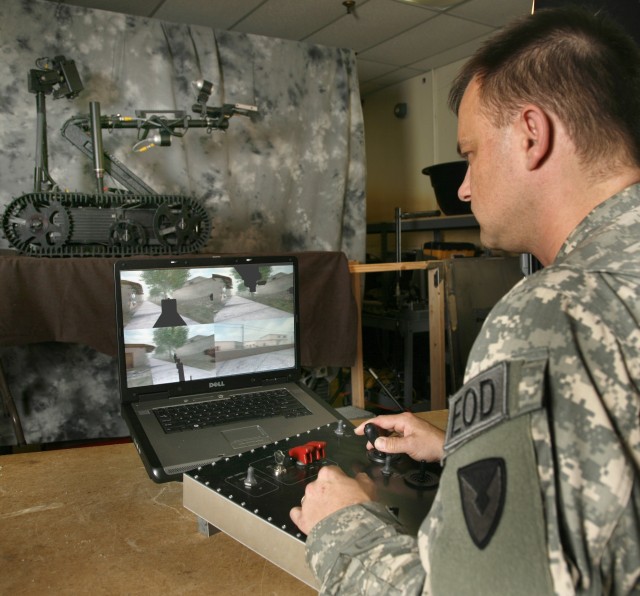With more than 8 million registered users, the Army-developed video game America's Army is an interactive, first-person shooter game that allows civilians a taste for the Soldier-life.
However, what debuted in 2002 as a communication tool for the Army to promote awareness and Army values to the general public has evolved into a practical training tool for Soldiers.
The Armament Research, Development and Engineering Center at Picatinny Arsenal, N.J., has used the game to develop training simulators to help familiarize Soldiers with the robots used to detonate improvised explosive devices.
The America's Army video game was spear-headed by Col. Casey Wardynski at the office of economics and manpower analysis at West Point, N.Y., said Brad Drake, computer engineer and team leader for America's Army - Picatinny.
Though the Armament Research, Development and Engineering Center had been doing simulation for a long time, when Picatinny simulation engineers saw the game, they wanted to put that level of detail into their graphics simulation, Drake said.
At that point, Drake said, the simulation team had minimal graphics in their designs - for instance they were using blocks as tanks - and engineers thought the America's Army graphics could be incorporated in training, simulations, prototyping, mission rehearsal and all types of other areas to assist Soldiers.
He also said that since the Army owned the license, they were able to give ARDEC the development code, editor and everything that came with the license.
However, getting the license was the easy part. Drake said that initially it was difficult to convince people the virtual training battlefield was a relevant one.
"It took a little while for people to see video games as a worthwhile way to train Soldiers," Drake said. "There was quite a bit of resistance up front, but now more and more people are accepting it."
The Picatinny team began by designing virtual prototyping technology for the XM25 grenade launcher that turned out to be more of a technology demonstrator.
Drake said that while it did not actually get into the Soldiers hands, it provided an awareness of how the new simulation technology could work.
The XM25 grenade is a 25 mm air-bursting munition, "so it's really cutting edge and ... difficult to show how that works on a power point," Drake said. "But with us implementing it into America's Army, we could kind of provide that 3-D feel of what it's going to look like, how it's going to behave and give people a much better feel for how it works."
The Talon and PackBot training simulation begin when the AA-Picatinny team paired with ARDEC's Explosive Ordnance Disposal Technology Directorate members.
The Foster-Miller Talon and iRobot PackBot are both tracked robots used to disarm improvised explosive devices. Because they are remotely operated and equipped with cameras, they allow Soldiers to safely detonate suspicious objects from a distance.
Sgt. 1st Class Jason Mero, who has served tours in both Iraq and Afghanistan, works in ARDEC's EOD Technology Directorate to help develop trainers for the Talon and PackBot robots.
The trainers are virtual robots that allow Soldiers to gain experience driving robots without actually having the robots present, Mero said.
The trainers were needed because when the Army stopped using the approximately 450-pound Andros robot in exchange for the lighter PackBot and Talons, they did not have enough robots to train with, he said.
While quantity is not such an issue these days, the approximately $140,000 cost of the Talons makes it cost-effective to train Soldiers with virtual robots before using the real robots, he continued.
"Use of a simulator reduces cost of repairs to the robot platform," Mero said. "Utilizing training systems help reduce roll-overs and silly accidents that shouldn't happen."
The Talon trainer, currently on its third upgrade, is physically similar to the Talon. The training control unit hooks into a laptop, which plays the Talon Trainer video game. The main controls for the video game are almost identical to the controls on the real Talon.
Mero said the trainers are meant to familiarize the operators with the controls as opposed to training them how to respond to different incidents and situations.
However, the operators also detonate different types of IEDs using an assortment of methods. The IEDs are found in locations realistic to where Soldiers would find when deployed, such as hidden in sandbags or in courtyards.
Mero said the AA-Picatinny team does all the code writing for the trainers - the EOD professionals give them scenarios they want and the AA team creates the graphics in-house.
Approximately 90 trainers are being used by all branches of the military. Unlike the America's Army video game, the trainers are available only to the military.


Social Sharing